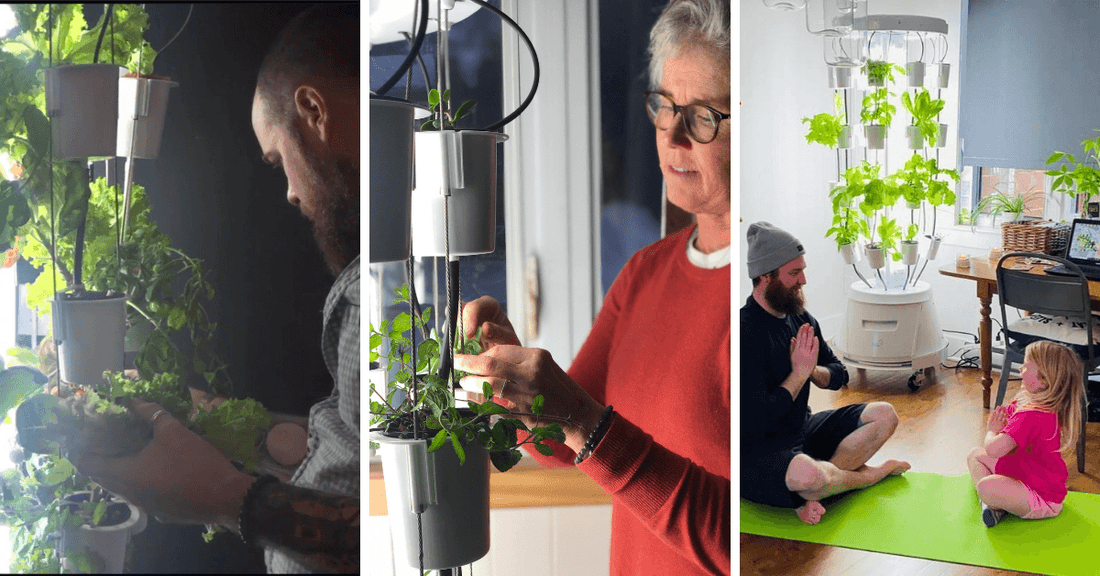
Minding the Garden: What is Horticultural Therapy?
Share
Author: Lauren Jelinek
This series, “Minding the Garden,” looks at how mental health and gardening interact. In this article, I begin an exploration of how gardening for fun and food can be beneficial to our mental health. In this first post, I’ll look at horticultural therapy and therapeutic gardens. Stay tuned for future posts to learn about the benefits of light therapy and discover the real world applications of both of these therapeutic forms through the Nutritower’s real-life placements in the mental health space.
Mental health struggles can affect anyone, but options for clarity and calm are available. As people are looking for more ways to manage stress, unwind, and connect with nature, a clear and accessible solution emerges: gardening.

Using gardening as a tool for bettering mental health is becoming increasingly accessible and dependable. Furthermore, plenty of links have been found between the effects of plants and gardening and positive mental health outcomes. Exploring how mental health is impacted by gardening and plants can help us come up with readily-available therapeutic solutions that are affordable and widespread.
At first glance, it’s easy to see how plants and gardening can contribute to moments of calm and happiness in our daily lives. Plants are passive and can be inexpensive, but allow gardeners to claim a sense of responsibility and purpose through caring for them. Growing something you can eat or aesthetically enjoy allows individuals to feel a sense of accomplishment, and the process of digging, planting and watering forces people to get out of their head, use their hands, and feel connected to the earth. Gardening as a whole is extremely affirming, satisfying, and relaxing, and can be a great way to manage stress. Studies have even found that being in or looking at green plant landscapes is linked with lessened anxiety and depression, better stress management, and other positive effects. The plethora of benefits from gardening helps to explain the popularity and efficacy of horticultural therapy, which integrates gardening practices into therapeutic endeavours.

It’s not hard to believe that looking out at or being among nature can relieve stress (source: Pexels).
Horticultural therapy is something that has been practiced since ancient times, but was first officially documented in the 19th century by Dr Benjamin Rush. He noted the positive effects working in the garden had on mental health. Throughout the 20th century, gardening became more integrated into rehabilitation practices and horticultural therapy became more respected and widespread. Now, it is used in a range of settings and for a wide range of diagnoses. Horticultural therapy has ample benefits: it can help participants learn or regain skills, and it improves memory, socialization, cognitive abilities, language skills, independence, problem solving skills, and even endurance and coordination.
Therapeutic gardens are an effective way for individuals to reap the benefits of horticultural therapy. These gardens are environments predominantly made up of plants, and they are designed to enable users to benefit from the healing potential of nature. There are many ways these gardens can be designed depending on individual preferences and needs, and there are several sub-types of therapeutic gardens such as restorative, healing, or rehabilitation gardens. Some key characteristics of therapeutic gardens could be supportive conditions, universal design, designated activities, and the facilitation of people-plant interaction, as well as well-defined perimeters and modifications to increase accessibility.

Therapeutic gardens can be designed in different ways, depending on the features users want to enhance in their experience of the garden (source: Pexels).
Although many therapeutic gardens are created through collaboration between landscape designers and horticultural therapists, they don’t need to be expensive or intricately planned for individual use. If you’re interested in creating a gardening space to benefit from some of the advantages of gardening for the body and mind, there are easy ways to start. Consider planting plants that are easy to grow, such as succulents or lucky bamboo, or herbs like chives, thyme, or mint (which is also a stress-reducing plant!). Starting with stress-free plants will help maximize their benefits and minimize anxiety towards creating the perfect garden. You should also consider your space and what is possible for you to achieve given your environment, skill level, and time commitment for your garden. If you live in a cold climate or are starting your garden in the winter, an indoor hydroponic system may be the best way to go. They are generally big enough to allow you to grow a lot but can still fit in smaller homes or apartments. Additionally, it allows you to garden year-round. You can always start with a few succulents on your desk to kick off your growing journey, but don’t be afraid to get into growing whatever interests you and you know you’ll enjoy, even in a backyard garden or growing tower.

If you want to grow a lot in a small space, a Nutritower growing tower may be the right solution for you.
Horticultural therapy, and gardening as a whole, has inevitable and undeniable benefits for mental health. No garden has to be perfect, it can start (or stay) very small and of course, sometimes plants die. What matters is getting involved in the process, trying your best, and reaping the many advantages of gardening and connecting with nature. Trying out the Nutritower, a vertical hydroponic garden system with a center column lighting, may be the right choice for you if you’re looking for a way to garden in your home throughout the year and experiments with growing different plants. Anyone can get started, so take this as your push to grow something today and see for yourself how rewarding it can be!
Nutritowers Facebook Growers group
